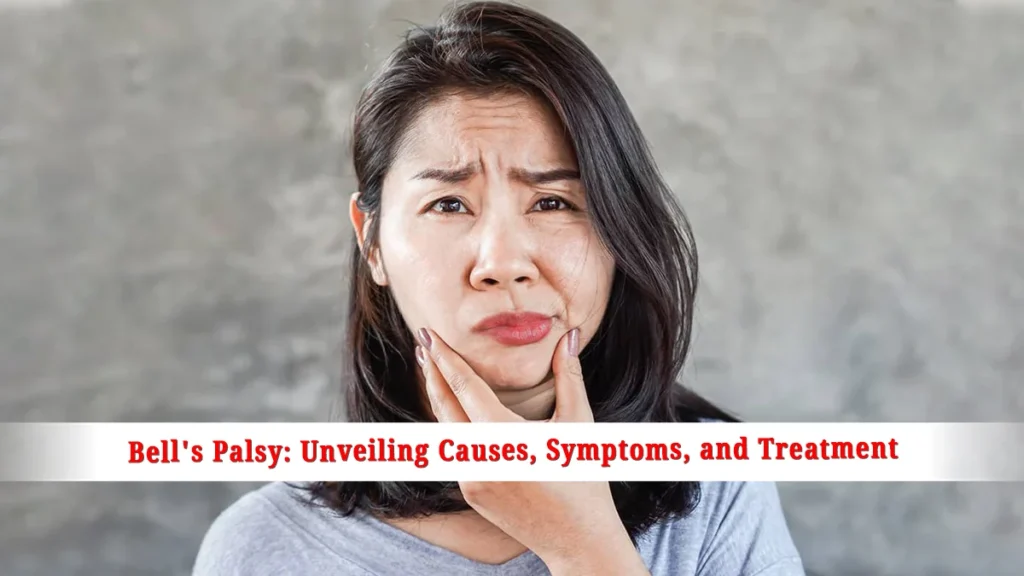Explore Bell’s Palsy causes, symptoms, and treatments to gain a comprehensive understanding of this condition. Informative guide for awareness.

Bell’s Palsy is a neurological condition characterized by the sudden onset of temporary facial paralysis or weakness. It affects the facial nerve, which controls the muscles on one side of the face, leading to various symptoms such as drooping of the face, difficulty in closing one eye or mouth, and other related issues.
Understanding the Causes
The exact cause of Bell’s Palsy is not fully understood, but it’s often attributed to two main factors:
Viral Infection: Most cases of Bell’s Palsy are believed to be caused by viral infections, particularly the herpes simplex virus (HSV) or the varicella-zoster virus (which also causes chickenpox and shingles). These viruses are thought to cause inflammation and swelling of the facial nerve, leading to its compression and subsequent paralysis.
Facial Nerve Compression: In some cases, Bell’s Palsy may occur due to compression or damage to the facial nerve, possibly from an injury or tumor growth.
Signs and Symptoms
The signs and symptoms of Bell’s Palsy can vary in severity but typically include:
- Sudden Weakness or Paralysis: Sudden onset of weakness or paralysis on one side of the face, which may make it difficult to smile or close the affected eye fully.
- Facial Drooping: One side of the face may appear droopy or sagging, leading to asymmetry in facial expressions.
- Difficulty Closing Eye or Mouth: Patients may experience difficulty in closing one eye completely or controlling the movement of the mouth on the affected side.
Diagnosis and Medical Evaluation
Diagnosing Bell’s Palsy typically involves a thorough medical evaluation to rule out other potential causes of facial paralysis and confirm the diagnosis.
Physical Examination: Assessing Facial Function
During a physical examination, healthcare providers assess facial muscle strength, symmetry, and coordination to identify signs of Bell’s Palsy. They may also evaluate other cranial nerves for any associated abnormalities.
Diagnostic Tests: Confirming the Diagnosis
While Bell’s Palsy is primarily diagnosed based on clinical presentation, additional tests such as electromyography (EMG) and imaging studies like MRI or CT scans may be performed to rule out other conditions and assess the extent of nerve involvement.
Treatment Options
Treatment for Bell’s Palsy focuses on managing symptoms, promoting nerve regeneration, and facilitating recovery. Various therapeutic interventions and supportive measures are available to address the unique needs of each individual.
Medications: Alleviating Inflammation and Pain
In some cases, corticosteroids such as prednisone may be prescribed to reduce facial nerve inflammation and hasten recovery. Antiviral medications may also be recommended, especially if a viral infection is suspected as the underlying cause.
Physical Therapy: Restoring Facial Function
Physical therapy plays a crucial role in Bell’s Palsy rehabilitation, helping individuals regain strength, mobility, and coordination in their facial muscles. Exercises targeting specific muscle groups can promote facial symmetry and improve functional outcomes.
Surgery (in rare cases): Exploring Surgical Options
In rare instances where facial nerve compression is identified, surgical interventions such as decompression or nerve grafting may be considered to alleviate pressure on the affected nerve and restore function.
Recovery and Prognosis
While the majority of individuals with Bell’s Palsy experience spontaneous recovery within weeks to months, the prognosis can vary depending on the severity of symptoms and promptness of treatment.
Timeframe for Recovery: Patience and Persistence
Most cases of Bell’s Palsy resolve within six months, with gradual improvement in facial muscle strength and function. However, some individuals may experience lingering symptoms or partial paralysis that require ongoing management.
Potential Complications: Addressing Challenges
Although rare, complications of Bell’s Palsy can occur, including synkinesis (involuntary muscle movements), facial contractures, and psychological distress due to changes in facial appearance. Early intervention and comprehensive care can mitigate these risks.
Living with Bell’s Palsy
Adjusting to life with Bell’s Palsy involves adapting to changes in facial function and implementing strategies to optimize quality of life. Supportive care, preventive measures, and self-management techniques play pivotal roles in empowering individuals with Bell’s Palsy.
Coping Strategies: Building Resilience
Coping with Bell’s Palsy requires resilience and a proactive approach to managing physical and emotional challenges. Engaging in relaxation techniques, mindfulness practices, and seeking social support can alleviate stress and promote well-being.
Supportive Care: Finding Strength in Community
Joining support groups and connecting with others who have experienced Bell’s Palsy can provide invaluable emotional support, practical advice, and encouragement throughout the recovery journey.
Prevention Measures: Safeguarding Facial Health
While the exact cause of Bell’s Palsy remains unknown in many cases, adopting certain preventive measures can help minimize the risk of developing this condition or reduce its severity.
Managing Stress: Prioritizing Self-Care
Stress management techniques such as meditation, yoga, and deep breathing exercises can help reduce the likelihood of triggering Bell’s Palsy episodes or exacerbating symptoms.
Good Hygiene Practices: Promoting Facial Wellness
Practicing good hygiene habits, including regular handwashing, avoiding close contact with individuals who are sick, and maintaining a clean environment, can help prevent viral infections that may contribute to Bell’s Palsy.
Support and Resources
Accessing reliable information, support services, and educational materials is essential for individuals affected by Bell’s Palsy and their caregivers. A wealth of resources is available to provide guidance, encouragement, and practical tips for managing the condition effectively.
Support Groups: Building a Supportive Community
Joining online or local support groups dedicated to Bell’s Palsy can foster connections with others facing similar challenges, offering empathy, shared experiences, and valuable insights into coping strategies and treatment options.
Educational Materials: Empowering Through Knowledge
Educational materials, including brochures, websites, and informational videos, serve as valuable tools for increasing awareness, understanding the condition, and promoting self-advocacy among individuals affected by Bell’s Palsy.
Frequently Asked Questions (FAQs)
Can you recover from Bell’s palsy?
Yes, recovery from Bell’s palsy is possible for many individuals. With appropriate treatment and time, most experience significant improvement within weeks to months. Early intervention with medications and supportive care enhances recovery chances. However, outcomes vary based on severity and individual response. Consulting healthcare professionals is essential for guidance.
What is the best treatment for Bell’s palsy?
The best treatment for Bell’s palsy typically involves corticosteroids to reduce inflammation, antiviral medications in some cases, and eye care to prevent complications. Facial exercises, massage, and acupuncture may aid in muscle retraining and relaxation. Protecting the affected side from extreme conditions is crucial. Supportive care, including rest and stress management, is important for overall well-being. Close collaboration with healthcare providers helps tailor treatment plans to individual needs. In severe or persistent cases, interventions like botulinum toxin injections or surgery may be considered.What are 4 symptoms of Bell’s palsy? Common symptoms of Bell’s palsy include facial drooping or paralysis on one side, difficulty closing one eye, drooling, difficulty eating and drinking, facial twitching or weakness, and altered taste sensation.
How to avoid Bell’s palsy?
While it’s not always possible to prevent Bell’s palsy, maintaining good overall health and hygiene practices can help reduce the risk. Avoiding exposure to viruses that can cause facial nerve inflammation, such as the herpes simplex virus, and managing stress levels may also be beneficial.
What foods should you avoid with Bell’s palsy?
There are no specific foods that individuals with Bell’s palsy need to avoid. However, some people may find that certain foods that require strong chewing or cause discomfort to the affected side of the face may be more difficult to eat.
What foods help with Bell’s palsy?
Eating a balanced diet rich in fruits, vegetables, whole grains, lean proteins, and healthy fats can support overall health and aid in recovery from Bell’s palsy. Additionally, foods high in vitamins B12, B6, and B9, as well as zinc and magnesium, may be beneficial for nerve health.
Does Bell’s palsy have warning signs?
Yes, Bell’s palsy can present with warning signs such as sudden weakness or paralysis on one side of the face, drooping of the mouth or eyelid, difficulty closing one eye, drooling, dryness or excessive tearing in one eye, altered sense of taste, and increased sensitivity to sound on the affected side.
Te Mend Final Thought
In conclusion, Bell’s Palsy is a temporary condition characterized by facial weakness or paralysis, often attributed to viral infection or nerve compression. While the exact cause remains elusive in many cases, timely diagnosis and comprehensive management strategies can facilitate recovery and improve quality of life for individuals affected by this condition.
“Good news! Te Mend is now available on WhatsApp & Telegram Channels. Subscribe today through the link and stay updated with the latest news!” Whatsapp & Telegram




